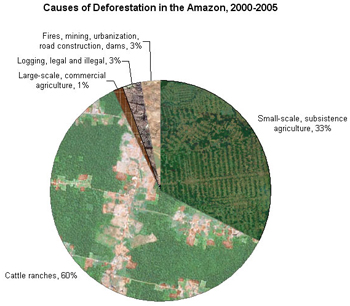Brazil to protect Amazon rainforest
Rhett A. Butler, mongabay.com
March 28, 2006
At the United Nations-sponsored environmental conference meeting in Curitiba, Brazil announced plans to protect an additional 210,000 square kilometers (84,000 square miles) of the Amazon rain forest in the next three years.
The Amazon, which covers around 4.1 million square kilometers in Brazil, Bolivia, Ecuador, Peru, Colombia and Venezuela, houses more than one-third of the world’s remaining rainforests. Scientists say the Amazon plays a critical role in global water cycles and climate regulation.
Despite its importance, Amazon ecosystems are disappearing due to conversion for cattle pasture and agriculture. Logging, mining and infrastructure development are also contributing to pressure on the region’s forests, which are among the most biodiverse on the planet.
Since 1970 at least 600,000 square kilometers (232,000 square miles) has been cleared in the Amazon. In recent years, growing populations in the Amazon region, combined with increased viability of agricultural operations, have fueled deforestation rates which, on an annual basis for primary forest areas, have climbed by 35 percent since the close of the 1990s. Scientists warned last week that 40 percent of the Amazon rainforest could be lost by 2050 due to agricultural expansion.
 Causes of Amazon deforestation. More on the Amazon rainforest |
Brazil’s latest announcement is part of the Amazon Protected Areas Program, which aims to slow forest loss through a system of protected areas and sustainable development initiatives which provide economic incentives for responsible use of forest resources. Under the program, earlier this year Brazil unveiled a plan to allow sustainable logging across 3 percent of the Amazon.
The protected area announcement comes as cabinet ministers from nearly 100 countries arrived for the Convention on Biological Diversity in Curitiba — 400 miles southwest of Rio de Janeiro. The convention aims to evaluate progress made towards conserving global biodiversity since the 1992 Earth Summit in Rio de Janeiro.
In opening remarks at the ministers’ meeting, Brazil’s President Luiz Inacio Lula da Silva blamed industrialized nations for the “unsustainable patterns of production and consumption” and called on wealthy nations to do more to protect the environment, echoing a proposal set forth by poor nations at the U.N. climate change talks last November.
Related articles
Amazon to be logged sustainably says Brazil March 6, 2006
Last week Brazilian president Luiz Inacio Lula da Silva announced a plan to allow sustainable logging across 3 percent of the Amazon rain forest. The law is aimed at undermining destructive illegal logging activities—currently responsible for most of the commercial timber extraction in the region—while generating revenue for forest management and protection, and income for rural Brazilians in the region who often must rely on subsistence agriculture or employment on ranches and plantations under sometimes slave-like conditions.
Parks, indian reserves slow Amazon deforestation January 25, 2006
new study shows that parks and indigenous reserves in the Amazon help slow deforestation. The study, conducted by researchers at the Woods Hole Research Center and the Instituto de Pesquisa Ambiental da Amazonia, analyzed the effectiveness of protected areas against forest clearing using quantitative analysis of satellite data. The study found that deforestation was 1.7 to 20 times higher along the outside versus the inside perimeter of reserves, while fires were 4 to 9 times higher. Indigenous lands also slowed forest clearing in high-deforestation frontier regions.
Amazon deforestation slows in Brazil for 2005 December 5, 2005
Deforestation in the Amazon rainforest fell 37% for the 2004-2005 year according to Brazilian government figures released today. Between July 2004 and August 2005, 7,298 square miles of rainforest (18,900 square kilometers) — an area almost half the size of Switzerland — were destroyed. Last year the figure was 10,088 square miles (26,129 sq km kilometers) and since 1978 some 211,180 square miles (546,905 sq km) of forest has been lost.
Pre-Columbian Amazon supported millions of people October 18, 2005
Controversial evidence uncovered over the past decade suggests that the Amazon rainforest was once home to large sedentary populations of people. Besides the well-known empires of the Inca and their predecessors, the Huari, millions of people once lived in the forests and shaped the environment to suit their own needs.